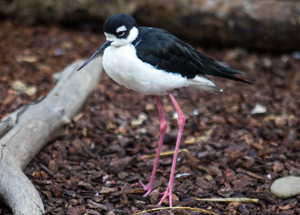
- VisitSupport Happy HollowDONATE TODAYExploreSupport Happy HollowDONATE TODAYLearnSupport Happy HollowDONATE TODAYSupport
-
Today's Hours: 10:00 am to 5:00 pm
Zoo in the HollowBlack-necked stilt

Scientific name: Himantopus mexicanus
Family: Recurvirostridae
Order: Charadriiformes
Class: Aves Range: Coastal regions of North, Central and South America
Habitat: Wetland
Lifespan: 5 to 10 years in the wild; Up to 20 years in captivityWhat do they look like?
This wading bird is around 14 inches long from beak to tail. They have a long, thin black bill which curves slightly upward and long, thin pinkish-red legs. Black-necked stilts have the longest legs comparative to their body size of any bird, apart from flamingos. They have white underparts and black wings and backs. The black extends from the back along the neck to the head, forming a “cap.” They have a small white spot just above the eyes. Males have a greenish gloss to the black feathers on their back and wings, particularly in the breeding season. This is less pronounced in females, which have a brown tinge to these areas instead.
How do they behave?
Stilts are usually found wading in shallow salt or freshwater wetlands, probing in the water with their beak for food. They rarely swim or dive. They are strong fliers, and will often swoop from one feeding location to another.
What do they eat?
These birds eat aquatic invertebrates, tadpoles and fish. They catch their prey with their sharp beak, either by stabbing through or grabbing them. They will also plunge their head under water to catch their prey. At Happy Hollow they eat insects, ground meat, specialized bird food and fish.
How are they born?
Black-necked stilts nest in large groups and cooperate to defend the perimeter of their breeding territory. Male and female pairs build a nest together, which consists of a shallow scrape lined with nearby debris including stones, grasses and shells. If a predator threatens the nests, the adult stilts will mob them, collectively attacking and harassing the predator to drive it away from the nest site. The female incubates her clutch of 1 to 5 eggs, which hatch around three weeks later. The newly hatched chicks are alert and active, able to leave the nest after just a few hours.
What should you know about them?
Some populations of black-necked stilt are migratory, wintering in the warmer regions like the Caribbean or Baja California, and breeding over the summer in the northern United States. They have adapted to human-impacted and constructed wetlands and are often found in irrigation ditches, water retention ponds and sewage treatment plants.
Conservation
The black-necked stilt’s conservation status has not been evaluated by the International Union for Conservation of Nature . However, these and other wading birds rely on healthy wetlands to survive and thrive. One of the easiest ways to preserve our wetlands is through water conservation. Water conservation can include something as simple as turning off the water when you are brushing your teeth to installing low-flow shower heads. Be aware of your local regulations for hazardous waste disposal, like batteries, oil, and paint. Remember that the drains on our streets often lead directly to wetlands without being treated first. If you are interested in fresh water preservation in the Bay Area please visit the Guadalupe River Park Conservancy at www.grpg.org

Zoo on the Hill
Located across from the Keep-Around Carousel is the Zoo on the Hill. Learn about wildlife up close during daily meet-and-greets, leap like a lemur on the playground, brush and feed the goats,, or take a peek inside Doc’s Critter Care building and the Ranch House. Double-H Ranch features a combination of animal exhibits, including giant anteaters and red ruffed lemurs, as well chickens and domesticated animals that are docile enough to touch.
See Animals
Education Ambassadors
From camps and classes to scout badges and sleepovers, Happy Hollow education programs have something for everyone! The zoo education program offers a broad range of hands-on, engaging programs and public presentations featuring education ambassador animals. These encounters are designed to connect you to wildlife and the conservation of their habitats around the world.
See AnimalsVisit Us Today
Plan an unforgettable experience at San Jose’s family-friendly park and zoo.
Learn More